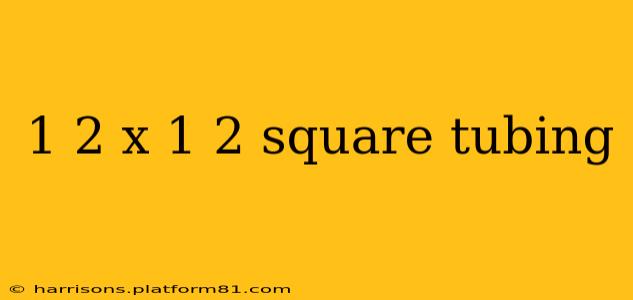The phrase "1 2 x 1 2 square tubing" likely refers to the dimensions of square tubing, commonly used in construction, manufacturing, and various DIY projects. However, the notation is ambiguous. Let's break down what this could mean and explore the important factors to consider when specifying square tubing.
What does "1 2 x 1 2 square tubing" mean?
The most probable interpretation is that "1 2 x 1 2" represents the outside dimensions of the square tubing in inches. This would mean the tubing has an outer width and depth of 1.2 inches. However, it's crucial to note that this is just one possibility. Without additional context (like the material, manufacturer, or a part number), there's room for misinterpretation. The number could also represent millimeters (12mm x 12mm) or even some other unit of measurement not commonly used.
What are the important specifications for square tubing?
When ordering or specifying square tubing, you need more than just the outer dimensions. Here are the key factors to consider:
Outer Dimensions: The width and depth of the square tubing's outside edge. This is usually expressed in inches or millimeters.
Wall Thickness: This refers to the thickness of the tubing's metal walls. A thicker wall means greater strength and rigidity. Wall thickness is usually specified in fractions of an inch (e.g., 1/8", 3/16", 1/4") or millimeters.
Material: Square tubing comes in a variety of materials, each with different properties:
- Steel: A strong, versatile, and widely available option. Different grades of steel offer varying levels of strength and corrosion resistance.
- Aluminum: Lighter than steel and corrosion-resistant, making it ideal for applications where weight is a concern.
- Stainless Steel: Offers excellent corrosion resistance and is often used in demanding environments.
Length: The length of the tubing is another essential specification. Standard lengths vary by manufacturer.
Finish: The tubing might have a specific finish, such as galvanized (zinc-coated for corrosion protection), powder-coated (for color and added durability), or mill finish (the natural finish of the material).
How to correctly specify square tubing
To avoid confusion, always specify the tubing's dimensions using a clear and consistent format. A standard format might look like this: "1.2" x 1.2" x 0.125" Square Tubing, Steel, 10ft." This clearly states the outer dimensions, wall thickness, material, and length.
What are the common uses of square tubing?
Square tubing is incredibly versatile and finds applications in many areas, including:
- Construction: Framing, structural supports, handrails.
- Manufacturing: Machine frames, jigs, fixtures.
- Automotive: Roll cages, chassis components.
- DIY Projects: Furniture, shelving, garden structures.
Are there different grades of square tubing?
Yes, the grade of square tubing (especially steel) refers to its chemical composition and mechanical properties. Different grades offer different levels of strength, hardness, weldability, and corrosion resistance. Consult a material supplier's catalog for specific grade information.
Where can I find square tubing?
Square tubing is widely available from metal suppliers, both online and offline. Check your local hardware stores, home improvement centers, and online metal distributors.
Remember, always double-check the specifications before purchasing to ensure you get the right tubing for your project. Incorrect specifications can lead to project delays and costly mistakes. Clear and precise communication with your supplier is key to obtaining the correct product.
